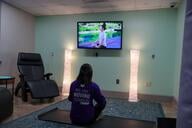You have /5 articles left.
Sign up for a free account or log in.

San Diego State University
iStockphoto.com/benedek
The California State University system is planning for the worst. The system's chancellor announced Tuesday in a virtual meeting with trustees that the university is moving ahead with a "virtual planning framework." Effectively, that means most courses in the fall are likely to be online.
The announcement comes amid a volley of messages from colleges and universities. Many of those that have said anything at all about the fall have stressed that they are "intending" or "planning" or "hoping" to reopen campuses, but they won't if it's not safe. CSU chancellor Timothy White flipped that message on its head. Instruction will be mostly virtual, he said, unless changes in the disease spread make it possible to have class in-person.
"That's our goal, to plan for the most rigorous, difficult moment, hope for the best moment, and find ourselves somewhere in between," he said in the meeting. "I hope we are wrong."
The announcement makes Cal State's 23 campuses the first major American universities to reverse the trend, joining the smattering a community colleges and junior colleges that have made similarly strong statements. The state system educates nearly 500,000 students, almost 5 percent of the college students in the United States.
White referred to forecasts from public health experts for re-emergence of the disease in late summer and fall.
"It is wise to plan now and over the next several months, with enriched training and improvements in virtual learning environments, only to pull back a bit in the fall for more in person as circumstances allow," he said. "But it would be irresponsible to approach it the other way around and wait until August, to only then scramble and not be prepared for a robust learning environment for our students."
Why Cal State?
Colleges have been under various pressures to signal a fall reopening, as prospective students have been wary of committing and current enrollees have demanded answers. While Cal State may be under pressures of its own, the system's situation is in some ways distinct.
CSU, unlike many other colleges, has not struggled with enrollment in recent years, said Carla Hickman, vice president of research at EAB, a higher ed consulting firm that works with the system and some of its campuses on research, technology, student success and academic affairs. Cal State has also made investments over the past decade in online education, she said, making the system better prepared than others.
Like many other public universities, the CSU system also serves many students who commute to campus from home.
"If you are principally an residential college and that is your mark in the world, it creates a different pressure," Hickman said. "That is the hallmark of the education that you offer."
Presidents at some colleges, such as Brown and Purdue Universities, have emphasized that appropriate testing and tracing for students and staff can keep campus safe and open. When asked by a trustee in the meeting why that was not feasible for CSU, Chancellor White said that to test half the student body weekly would cost around $25 million per week.
"At the moment financially, testing everyone is not in the cards," White said.
Additionally, Cal State faculty are unionized with the California Faculty Association, and the contract for academic-year faculty will be ending in a few weeks.
Charles Toombs, president of the CFA and a professor of Africana studies at San Diego State University, said that those few weeks should be enough time for most faculty to move their classes online delivery, but not all.
Faculty are not required to work off contract and must be compensated for any work that they do volunteer for, Toombs said. The Cal State administration will be holding trainings and other opportunities for faculty to use the summer to plan, but these will be optional, Toombs said, and faculty must be compensated for participation.
Neither faculty nor their union were involved with the decision for a virtual planning framework, Toombs said, but their participation going forward is vital. Faculty who teach the limited in-person classes may have concerns about their safety, he said.
"Administrations on campus and the chancellor's office must talk to faculty. They must be at the table in the planning for how the fall unfolds."
What Will a Virtual Fall Look Like?
White emphasized that there will be limited opportunities for in-person instruction. Courses that can't take place virtually, that are vital to a university's mission and can be conducted safely, will go on, he said. Classes in nursing, creative arts and maritime studies, along with physical science labs, may all require some level of in-person training.
White said that there will likely be variability in what is possible at each of the system's nearly two dozen campuses. On campuses where the disease burden is low, more in-person instruction might be available.
Hickman said the reduced in-person activities Cal State is planning for are similar to conversations she's had with leadership at other universities, with very few looking at fully in-person instruction. Some disciplines, such as health sciences, may have in-person requirements for accreditation purposes, she said.
Ultimately, other universities may follow Cal State's lead.
"It gives folks permission to see that that is a valid choice," Hickman said. "Someone had to go first."








